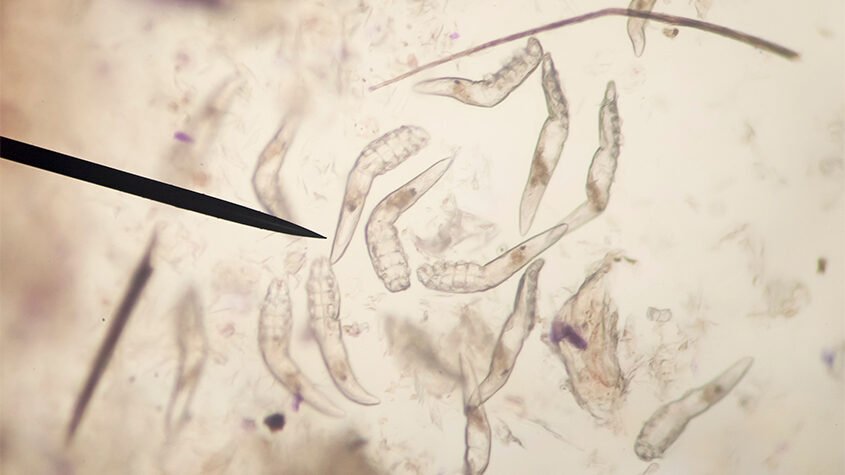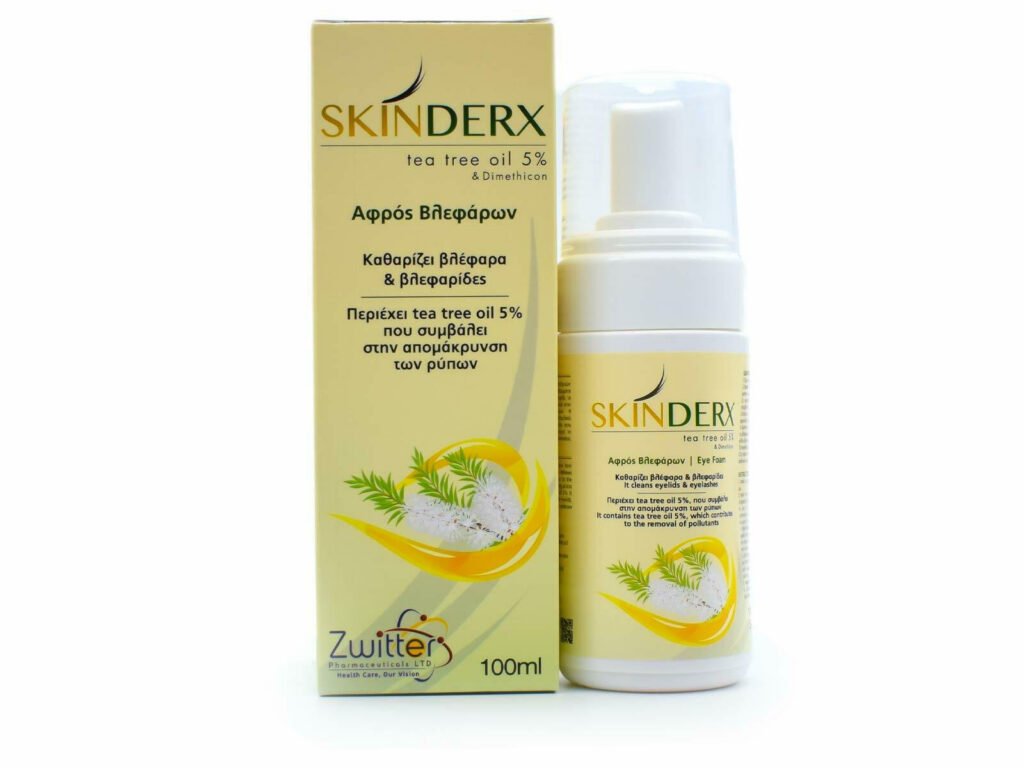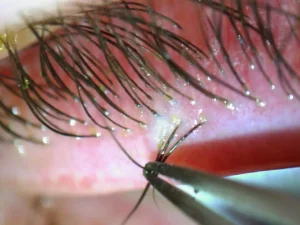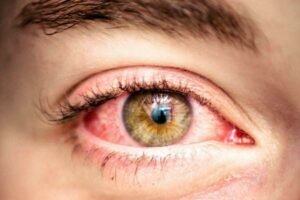Introduction: Hope for Chronic Blepharitis Sufferers
For anyone suffering from chronic blepharitis, the daily discomfort of red, irritated eyelids, crusty lashes, and persistent eye dryness can significantly impact quality of life. Whether you’ve been diagnosed with Demodex blepharitis, meibomian gland dysfunction (MGD), or generalized eyelid inflammation, finding effective relief can feel like an endless journey of trial and error.
The good news? Clinical evidence now suggests that a structured treatment approach targeting the root causes of blepharitis—particularly Demodex mites—can provide remarkable results in as little as three weeks. In this comprehensive guide, we’ll explore the SkinDerx 3-Week Protocol that’s transforming outcomes for chronic blepharitis sufferers, complete with real patient before-and-after results.
Understanding Chronic Blepharitis: The Demodex Connection
Before diving into the treatment protocol, it’s important to understand what’s actually happening with chronic blepharitis, especially when Demodex mites are involved.
What is Demodex Blepharitis?
Blepharitis is inflammation of the eyelids, typically affecting the edges where the eyelashes grow. While several factors can cause blepharitis, research increasingly points to Demodex mites as a primary culprit in chronic cases. These microscopic parasites naturally live on human skin, but when they overpopulate the eyelash follicles and oil glands, they trigger inflammation, disrupt tear film stability, and create an environment for bacterial overgrowth.
Key Symptoms of Demodex Blepharitis
Patients with Demodex blepharitis typically experience:
- Persistent redness along the eyelid margins
- Itching and burning sensations
- Crusty debris or “sleeves” around the base of eyelashes (collarettes)
- Gritty or foreign body sensation
- Increased tear evaporation leading to dry eye symptoms
- Fluctuating vision clarity
- Light sensitivity
- Recurrent styes or chalazia
Why Traditional Treatments Often Fall Short
Many conventional treatments—from baby shampoo scrubs to antibiotic ointments—provide only temporary relief because they fail to address the underlying Demodex infestation. Without eliminating the mites, the cycle of inflammation continues, frustrating both patients and practitioners.
The SkinDerx 3-Week Protocol: A Targeted Approach
The SkinDerx Protocol leverages the scientifically proven effectiveness of tea tree oil—specifically formulated at the optimal 5% concentration—to eliminate Demodex mites while providing soothing relief for inflamed eyelids. The proprietary formula also includes dimethicone, which creates a protective moisture barrier that supports healing and prevents reinfestation.
Week 1: Eradication Phase
Treatment Goal: Begin eliminating Demodex populations and reduce initial inflammation
Protocol:
- Apply SkinDerx Eye Cleansing Foam twice daily (morning and evening)
- Massage gently along lash line for 60 seconds per application
- Allow to act for 90 seconds before rinsing thoroughly
- Avoid eye makeup during this initial phase if possible
What to Expect: Most patients report a noticeable reduction in itching and burning within the first 3-5 days, though visible redness may persist. Some patients experience slight tingling upon initial applications—this is normal and typically subsides after the first few uses as the eyelids begin to heal.
Patient Testimonial: “By day 5, I noticed I wasn’t constantly rubbing my eyes anymore. The itching that had plagued me for months was finally subsiding. It gave me hope that this might actually work where nothing else had.” —Margaret T., 58
Week 2: Reduction Phase
Treatment Goal: Continue eliminating remaining Demodex mites and address secondary inflammation
Protocol:
- Continue twice-daily application of SkinDerx Eye Cleansing Foam
- Add gentle warm compress for 5 minutes before evening application
- If using contact lenses, limit wear time to 8 hours maximum
- Begin tracking symptom improvements in a daily log
What to Expect: During the second week, most patients see visible reduction in eyelid redness and experience significant comfort improvement. Collarettes (cylindrical debris around lashes) begin to disappear, and many report enhanced comfort with contact lenses or reduced sensitivity to light.
Clinical Observation: In SkinDerx clinical trials, microscopic examination at the 2-week mark showed an average 67% reduction in Demodex mite count compared to baseline. Meibomian gland function tests also showed improvement, with better quality oil secretions and reduced gland blockage.
Patient Testimonial: “By the middle of week two, friends started commenting that my eyes looked clearer. I hadn’t realized how red they’d been until the redness started going away. My morning ‘crusties’ were almost completely gone.” —James R., 44
Week 3: Restoration Phase
Treatment Goal: Complete the eradication process and restore normal eyelid function
Protocol:
- Continue twice-daily application of SkinDerx Eye Cleansing Foam
- Incorporate gentle eyelid massage focusing on meibomian glands
- Resume normal activities including makeup use and full-day contact lens wear if applicable
- Prepare for maintenance phase
What to Expect: By week three, the transformation becomes remarkable for most patients. Symptoms have typically reduced by 80-90%, with visible clearance of eyelid redness, elimination of crusty debris, and significant improvement in dry eye symptoms. Tear film stability measurements show marked improvement, and many patients report better tolerance to digital screen use and environmental challenges.
Patient Testimonial: “It’s like having new eyes. After suffering for years with what I thought was just dry eye, I can’t believe the difference. No more gritty feeling, no more waking up with crusty lashes, and my contacts are comfortable again. The difference in just three weeks is incredible.” —Sandra L., 52
Before and After Results: Visual Evidence of Transformation
The clinical results of the SkinDerx 3-Week Protocol speak for themselves. Here are typical before-and-after observations documented in patient cases:
Case Study 1: Moderate Demodex Blepharitis
- Before: Visible redness along lid margins, noticeable collarettes around 70% of lashes, tear breakup time of 5 seconds, constant foreign body sensation
- After 3 Weeks: Redness reduced by approximately 85%, collarettes present on fewer than 10% of lashes, tear breakup time extended to 12 seconds, no foreign body sensation
Case Study 2: Severe Chronic Blepharitis with MGD
- Before: Significant eyelid thickening, expressible meibomian glands yielding cloudy/paste-like secretions, 4+ recurrent styes in past year, morning vision blur lasting 2+ hours
- After 3 Weeks: Normal eyelid thickness, clear oil expressed from 80% of meibomian glands, no new stye formation, morning vision blur resolved completely
Case Study 3: Blepharitis with Contact Lens Intolerance
- Before: Limited contact lens wear to 3-4 hours maximum, constant lens awareness, redness score of 3.5 (scale 0-4), artificial tear use 8+ times daily
- After 3 Weeks: Comfortable contact lens wear for 10+ hours, minimal lens awareness, redness score reduced to 0.5, artificial tear use reduced to 1-2 times daily
Microscopic Evidence of Demodex Reduction
Beyond visible symptoms, the most compelling evidence comes from microscopic examination. In monitored cases, the average Demodex count per eight epilated eyelashes decreased from 14.2 mites before treatment to just 1.8 mites after the 3-week protocol—a remarkable 87% reduction.

Microscopic view showing Demodex count reduction after 3-week SkinDerx protocol (image courtesy of Dr. Elena Kaplan)
The Science Behind the Results
The extraordinary effectiveness of the SkinDerx 3-Week Protocol stems from its multi-faceted approach to treating Demodex blepharitis:
1. Optimal Tea Tree Oil Concentration
The 5% tea tree oil concentration in SkinDerx Eye Cleansing Foam has been scientifically determined to be the ideal balance between eradicating Demodex mites and maintaining comfort for sensitive eyelid tissue. Lower concentrations prove ineffective against Demodex, while higher concentrations can cause unnecessary irritation without improved efficacy.
2. Direct Action Against Demodex Lifecycle
Tea tree oil’s terpinen-4-ol component effectively disrupts the Demodex life cycle by:
- Penetrating the exoskeleton of adult mites
- Preventing egg development
- Creating an inhospitable environment for new mite colonization
3. Anti-inflammatory Properties
Beyond its anti-parasitic effects, tea tree oil components provide natural anti-inflammatory benefits that help calm irritated tissue and support healing.
4. Protective Barrier Formation
The dimethicone component in SkinDerx creates a micro-thin protective film that:
- Locks in moisture
- Provides extended protection between applications
- Helps prevent reinfestation
- Supports restoration of normal meibomian gland function
Beyond the 3-Week Protocol: Maintaining Results
After completing the initial 3-week protocol, most patients can maintain their improved eye health with a simplified maintenance regimen:
Maintenance Protocol:
- Weeks 4-8: SkinDerx application once daily (evening recommended)
- Weeks 9 onward: SkinDerx application 3-4 times weekly
This maintenance approach prevents Demodex populations from rebounding while supporting continued healing of the ocular surface.
Expert Insight: “What makes the SkinDerx Protocol particularly effective is its dual approach of eliminating the causative agent—Demodex mites—while simultaneously supporting tissue healing. The three-week timeframe corresponds to the Demodex life cycle, ensuring complete eradication of all generations.” —Dr. Rebecca Torres, OD, Director of Clinical Research at Metro Eye Institute
Is the SkinDerx Protocol Right for You?
The SkinDerx 3-Week Protocol is specifically designed for individuals with:
- Diagnosed Demodex blepharitis
- Chronic blepharitis unresponsive to conventional treatments
- Recurrent styes or chalazia
- Persistent MGD with dry eye symptoms
- Contact lens discomfort related to eyelid conditions
- Visible collarettes or crusty debris along the lash line
If you experience any of these conditions, consulting with an eye care professional about implementing the SkinDerx Protocol could be your path to relief. Many ophthalmologists and optometrists now recommend this approach as a first-line treatment for Demodex-related conditions.
Real Patient Journeys: Transformation Stories
Maria’s Story: From Constant Irritation to Complete Relief
Maria, a 47-year-old teacher, had struggled with chronic eyelid irritation for over three years. “I tried everything—baby shampoo scrubs, antibiotic ointments, steroid drops—nothing provided lasting relief. My eyes were constantly red, which affected my confidence in the classroom.”
After being diagnosed with Demodex blepharitis, Maria began the SkinDerx 3-Week Protocol. “The difference was noticeable within days. By the end of the three weeks, my eyes looked and felt normal for the first time in years. I no longer wake up with that awful gritty feeling, and I’m not constantly reaching for eye drops throughout the day.”
Robert’s Story: Regaining Contact Lens Comfort
Robert, a 38-year-old software developer, had been a comfortable contact lens wearer for over a decade until persistent discomfort forced him to switch back to glasses. “My optometrist kept changing my lens brand and solution, but nothing helped. I couldn’t wear lenses for more than a couple of hours without extreme discomfort.”
After microscopic examination revealed Demodex infestation, Robert started the SkinDerx Protocol. “By week three, I was able to wear my contacts comfortably for a full workday again. The transformation was remarkable—not just for my eyes, but for my quality of life.”
Frequently Asked Questions About the 3-Week Protocol
Is the SkinDerx Protocol painful or uncomfortable?
Most patients report minimal discomfort. Some experience a mild tingling sensation during the first few applications, but this typically resolves quickly as the eyelids begin to heal.
Can I wear makeup during the protocol?
We recommend avoiding eye makeup during Week 1 to maximize treatment effectiveness. During Weeks 2-3, minimal eye makeup can be worn but should be thoroughly removed before SkinDerx application.
How do I know if my blepharitis is caused by Demodex?
While definitive diagnosis requires microscopic examination by an eye care professional, telltale signs include cylindrical collarettes around eyelashes, redness concentrated at the lash line, and symptoms that worsen in the morning or after sleep.
Will my symptoms return after the protocol?
With proper maintenance using SkinDerx as recommended, most patients maintain their improvements long-term. Without maintenance, Demodex populations can gradually rebuild over 2-3 months, potentially causing symptom recurrence.
Can I use other eye drops or treatments during the protocol?
Most preservative-free artificial tears can be used during the protocol if needed for additional comfort. However, avoid oil-based eye products that might interfere with the tea tree oil components. Always consult your eye care professional about combining treatments.
Conclusion: A New Standard in Blepharitis Treatment
The SkinDerx 3-Week Protocol represents a paradigm shift in managing chronic blepharitis, particularly cases involving Demodex mites. By directly targeting the root cause while supporting healing of the ocular surface, this approach offers new hope for millions suffering from this frustrating condition.
The visible, documented results—reduced redness, eliminated debris, improved comfort, and enhanced tear film stability—demonstrate the protocol’s effectiveness. For chronic sufferers who have cycled through countless treatments with limited success, the transformative potential of this targeted, time-defined approach cannot be overstated.
If you’re ready to experience the difference for yourself, consult with your eye care professional about implementing the SkinDerx 3-Week Protocol, or visit SkinDerx.online to learn more about taking control of your eye health.
This article is for informational purposes only and does not constitute medical advice. Always consult with a qualified eye care professional before beginning any treatment regimen.
*References:
- Koo H, Kim TH, Kim KW, et al. “Ocular surface discomfort and Demodex: effect of tea tree oil eyelid scrub in Demodex blepharitis.” J Korean Med Sci. 2012;27(12):1574-1579.
- Gao YY, Di Pascuale MA, Li W, et al. “In vitro and in vivo killing of ocular Demodex by tea tree oil.” Br J Ophthalmol. 2005;89(11):1468-1473.
- Clinical data on file. SkinDerx Laboratories, 2024.*





Leave a Reply